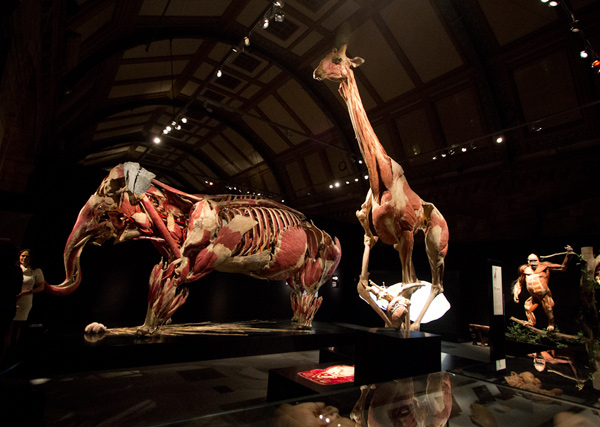
And for those interested in the process, the Institute for Plastination team take the following steps to plastinate an animal:
Embalming and dissection First the animal has formalin pumped into its body to stop the natural process of decay and to kill any bacteria. Then it is decided what particular structure the animal is going to show and skin, fatty and connective tissues are removed as required.
Removal of body fat and water The animal specimen is placed into an acetone bath. Acetone is a solvent that replaces the water and fatty tissues that remain in the body.
Forced impregnation After this, the specimen is immersed in a liquid polymer and placed in a vacuum chamber. The vacuum sucks the acetone out of the animal’s tissues as it evaporates and the resulting vacuum in the specimen forces the polymer solution to enter in its place. This process of removing the acetone and forcing in the polymer solution continues until all of the animal’s tissues have been totally saturated.
Positioning While the specimen is still malleable it is placed into its final position for display and then held in place until it sets using wires, clamps and needles.
Curing Finally the specimen is hardened using gas, light or heat depending on the material used. This ensures the specimen lasts for a long time and can be used in exhibitions and for education.And for those interested in the process, the Institute for Plastination team take the following steps to plastinate an animal:
Embalming and dissection First the animal has formalin pumped into its body to stop the natural process of decay and to kill any bacteria. Then it is decided what particular structure the animal is going to show and skin, fatty and connective tissues are removed as required.
Removal of body fat and water The animal specimen is placed into an acetone bath. Acetone is a solvent that replaces the water and fatty tissues that remain in the body.
Forced impregnation After this, the specimen is immersed in a liquid polymer and placed in a vacuum chamber. The vacuum sucks the acetone out of the animal’s tissues as it evaporates and the resulting vacuum in the specimen forces the polymer solution to enter in its place. This process of removing the acetone and forcing in the polymer solution continues until all of the animal’s tissues have been totally saturated. Positioning While the specimen is still malleable it is placed into its final position for display and then held in place until it sets using wires, clamps and needles.
Curing Finally the specimen is hardened using gas, light or heat depending on the material used. This ensures the specimen lasts for a long time and can be used in exhibitions and for education.

If your interested in looking at pictures of the exhibition here is a great link
ReplyDeletehttp://www.notcot.com/archives/2012/04/animal-inside-out-at-the-nhm-w.php
I wonder how they got the colors to match the authentic muscles or other tissues. Looks like it would be a great exhibit to walk through.
ReplyDeleteperhaps via computer? I know that these days stores have the capability to scan a painted object and recreate the exact hue.
ReplyDeleteI was fascinated by the Body Works Exhibition... I recall some time after posting it here in Multiply. Jen, a friend in Multiply was visiting NY (USA) and was lucky enough to see the Body Works Exhibition herself.
ReplyDeletescrolling down through the photos at the above link, I was a little uncomfortable viewing some of the exhibits. for instance the horses' head cut into thirds.
I know what you mean. The horse was a disembodied head, but it looked real, the parts that still looked like a horse.
ReplyDeleteThe colors of the plastic would have to be somehow designed into the process. By themselves, plastics are usually white or translucent to clear once they polymerize and they don't generally take paints well. Pretty fantastic job of color matching and polymerization techniques to get it to come out so well. I think my favorite was the elephant.
I remember seeing a documentary about the process, and how they were applying it to a blue whale... can you imagine? I wonder if it worked.... the process wasn't completed when the show was filmed.
ReplyDeleteThe Body Works exhibition was here in Montreal. I couldn't bring myself to go. A lil ashamed of the voyeurism to my desire to *see*... I walked away. A lil worried about the effect it would all have on my psyche.... maybe I'm a lil too sensitive to take away the human factor of it all.
"the animal has formalin pumped into its body to stop the natural process of decay and to kill any bacteria"....
ReplyDeletewhere can i get some of that formalin?!?!?!?!?!? please send me a link!!!!
interesting exhibit... intriguing, even...
now, please send me the link!!!!! i gots to get re-formalinated!!!
Hi Michele... I think if one is able to dissassociate one's self from the human factor.. the living factor... then the exhibition would be truly fascinating.
ReplyDeleteIm going to find me some too Dave(id)
ReplyDeleteI found this really interesting.. when I viewed the picture of the Rabbit I didnt realise exactly what I was veiwing.
ReplyDeleteThis is the preserved circulatory system of the rabbit
http://www.bbc.co.uk/nature/17608399